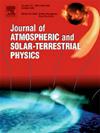Separation frequency of large-scale anisotropic eddies and small-scale isotropic eddies in the near-neutral and unstable atmospheric surface layer
IF 1.8
4区 地球科学
Q3 GEOCHEMISTRY & GEOPHYSICS
Journal of Atmospheric and Solar-Terrestrial Physics
Pub Date : 2025-02-01
DOI:10.1016/j.jastp.2025.106429
引用次数: 0
Abstract
High-frequency fluctuations of streamwise, spanwise, and vertical velocity components were measured in the logarithmic region of the atmospheric surface layer (ASL) to analyze the separation frequency of large-scale anisotropic eddies and small-scale isotropic eddies in high Reynolds number wall turbulence. The experimental results indicate that the separation frequency decreases exponentially with height and increases linearly with friction velocity in the near-neutral ASL. Furthermore, our study investigated the impact of atmospheric thermal stability on the separation frequency and revealed a decrease in the separation frequency with increasing thermal buoyancy in the ASL. By analyzing the mean wind shear in the near-neutral and unstable ASL at different heights, our study suggested that mean wind shear destroys large-scale turbulent eddies, transforming them into small-scale turbulent eddies. This phenomenon may lead to variations in the separation frequency with height, friction velocity, and atmospheric thermal stability. Our findings may shed new light on the understanding of atmospheric turbulence dynamics and its implications for the local-isotropy hypothesis in the ASL.
近中性和不稳定大气表层大尺度各向异性涡旋和小尺度各向同性涡旋的分离频率
在高雷诺数壁面湍流中,测量了大气表层的流向、展向和垂直速度分量的高频波动,分析了大尺度各向异性涡旋和小尺度各向同性涡旋的分离频率。实验结果表明,在近中性ASL中,分离频率随高度呈指数下降,随摩擦速度呈线性增加。此外,我们还研究了大气热稳定性对分离频率的影响,发现随着热浮力的增加,分离频率降低。通过分析不同高度近中性和不稳定ASL的平均风切变,我们认为平均风切变破坏了大尺度湍流涡旋,将其转化为小尺度湍流涡旋。这种现象可能导致分离频率随高度、摩擦速度和大气热稳定性的变化。我们的发现可能会对大气湍流动力学的理解及其对ASL局地各向同性假说的影响有新的启示。
本文章由计算机程序翻译,如有差异,请以英文原文为准。
求助全文
约1分钟内获得全文
求助全文
来源期刊

Journal of Atmospheric and Solar-Terrestrial Physics
地学-地球化学与地球物理
CiteScore
4.10
自引率
5.30%
发文量
95
审稿时长
6 months
期刊介绍:
The Journal of Atmospheric and Solar-Terrestrial Physics (JASTP) is an international journal concerned with the inter-disciplinary science of the Earth''s atmospheric and space environment, especially the highly varied and highly variable physical phenomena that occur in this natural laboratory and the processes that couple them.
The journal covers the physical processes operating in the troposphere, stratosphere, mesosphere, thermosphere, ionosphere, magnetosphere, the Sun, interplanetary medium, and heliosphere. Phenomena occurring in other "spheres", solar influences on climate, and supporting laboratory measurements are also considered. The journal deals especially with the coupling between the different regions.
Solar flares, coronal mass ejections, and other energetic events on the Sun create interesting and important perturbations in the near-Earth space environment. The physics of such "space weather" is central to the Journal of Atmospheric and Solar-Terrestrial Physics and the journal welcomes papers that lead in the direction of a predictive understanding of the coupled system. Regarding the upper atmosphere, the subjects of aeronomy, geomagnetism and geoelectricity, auroral phenomena, radio wave propagation, and plasma instabilities, are examples within the broad field of solar-terrestrial physics which emphasise the energy exchange between the solar wind, the magnetospheric and ionospheric plasmas, and the neutral gas. In the lower atmosphere, topics covered range from mesoscale to global scale dynamics, to atmospheric electricity, lightning and its effects, and to anthropogenic changes.
 求助内容:
求助内容: 应助结果提醒方式:
应助结果提醒方式:


